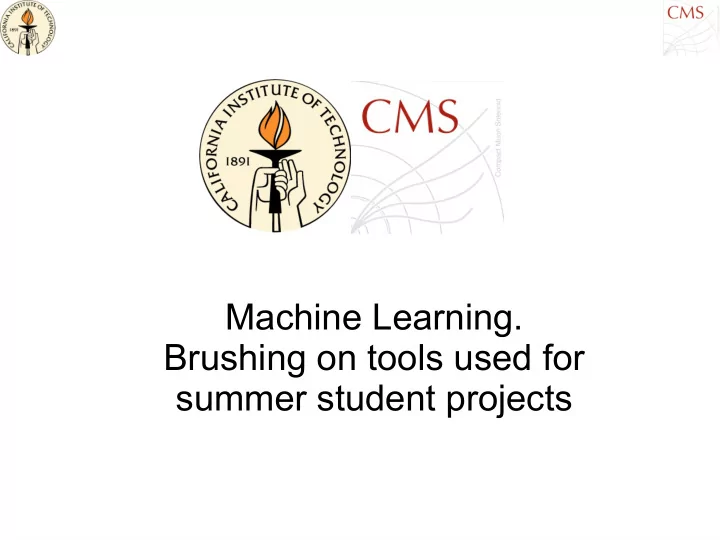

Machine Learning. Brushing on tools used for summer student projects
Overview ● Workbooks available online ➢ https://cms-caltech-ml.cern.ch/tree ➢ CERN Open Stack VM ➢ iPython server under Apache 2.4 ➢ Access limited to e-group cms-caltech-ml@cern.ch ➢ Authentication by CERN single sign-on ● GPU available ➢ GeForce GT 610 on pccitevo.cern.ch (Jean-Roch's desktop) ➢ Tesla K40c on felk40.cern.ch (courtesy Felice Pantaleo. CERN) ➢ Useful only for theano based code so far ➢ Download a notebook as python script and run locally THEANO_FLAGS=mode=FAST_RUN,device=gpu,floatX=float32 python code.py ➢
matplotlib http://matplotlib.org/ ● Python library for graphical representation ● Documentation is a bit scattered around ● Lots of practical examples existing ● Used for clustering with k-means, and PCA ● Self-Organizing map getting implemented https://github.com/scikit-learn/scikit-learn/pull/2996 much discussion about it on-going
numpy http://www.numpy.org/ ● Python library for scientific computation ● Documentation is a bit opaque ● Lots of practical examples existing ● Syntax can be very cryptic, but very powerful ● ROOT i/o not much supported in python libraries ● Used for dataset manipulation
h5py http://www.h5py.org/ ● Python library for managing (big) dataset ● Supported on multiple platform ● Strong documentation ● i/o for large dataset ● Dataset engine for NADE (see later) ● Only barely used so far at its full potential
scikit-learn http://scikit-learn.org/dev/index.html ● Python library for machine learning ● Well documented suite of methods ● Lots of example to get started ● Implements most of the classical supervised methods (PCA, SVM, Random forest, …) ● Implements several unsupervised clustering algorithm (k-means, …) ● Used for clustering with k-means, and PCA ● Self-Organizing map getting implemented https://github.com/scikit-learn/scikit-learn/pull/2996 much discussion about it on-going e h t r o f d e r e l u b d m e e p h v o c o h S N s k r o w
pybrain http://pybrain.org/ ● Python library for neural net training ● Well documented ● Easy to get started on neural-net training ● Does not support GPU acceleration ● Used initially to get started with NN ● Faced performance issues early on
theano http://deeplearning.net/software/theano/ ● Python library for manipulating mathematical expressions ● Very complete library ● Intensive tutorial available ● A bit opaque to use by itself ● Full GPU acceleration support ● A bit like cernlib, requires higher level software wrapper ● Easy software manipulation comes with performance hit ● Used for convolutional neural network implementations ● Used as mathematical engine for higher level libray e h t r o f d e r e l u b d m e e p h v o c o h S N s k r o w
theanets http://theanets.readthedocs.org ● Python library for neural net training ● Feels like “pybrain done right” ● Easy to get started on neural-net training ● Use theano as computation engine ● Now used for neural nets in three projects
rNADE http://www.benignouria.com/en/research/RNADE/ http://arxiv.org/abs/1306.0186 ● Python software for neural autoregressive density estimator ● In touch with the authors Ian Murray, Hugo Larochelle, Benigno Uria. ● Transformed into a python library for usage inside noteboooks ● Benchmarking for usability in background estimation ● Possible solutions for outliers detection suggested by the authors
Deep Learning ● Kolmogorov's Theorem http://www.sciencedirect.com/science/article/pii/0893608092900128 ● “Make it deep enough and it will learn anything” ● Provided … ➢ Enough data to fit all the parameters ➢ Enough computing acceleration
spearmint https://github.com/HIPS/Spearmint ● Software to perform bayesian optimization ● Utilized for neural net optimization in the UCI Higgs2tautau/razor papers ● Will use to optimize NN topologies e h t r o f d e r e l u b d m e p e h o v c h o S s N k r o w
NMS Projects Overview ● Assuming Kolmogorov's theorem : we can learn anything ● NN Tracking ✔ Present the full list of hits ✔ Train on hit/track association ➔ Get track candidate categorization ➔ Software acceleration ➔ Possibility of optimization with respect to exiting tracking ● NN Trigger ✔ Present low level reconstruction objects ✔ Train on trigger bits ➔ Emulate the trigger selection ➔ Software acceleration, no optimization with respect to existing trigger table, could free a good fraction of timing in the HLT ● NN Calo Id ✔ Present energy deposition in a jet ✔ Train on generator particle identity ➔ Get the jet “label” (quark, gluon, photon, electron, …) ➔ Has a huge potential impact. Room for optimization
Cost Function and Regularisation ● Regularization is adding sum of squared weights in the cost function. ● Supposed to stabilize and prevent over fitting. ● Observation was that Error (NN mismatch with target) was going down as expected but cost growing back during training. ● Explanation is that discrete gradient descent is going over a barrier in cost to reach out towards a better fit.
NN HLT 1/2
NN HLT 2/2
Recommend
More recommend